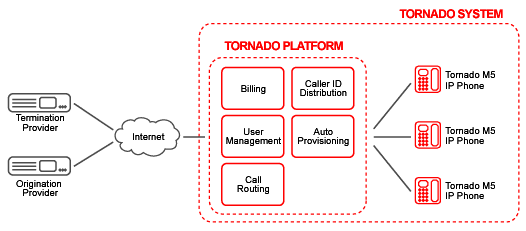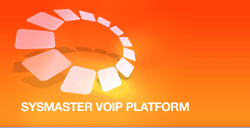Tornado System
Overview
| Tornado Platform |
 |
Business Opportunity
Voice-over-IP service provider is looking to implement a low-cost Broadband VoIP system that would enable him to offer VoIP telephony services to residential and small business customers. He needs a system that can provide both basic connectivity and value-added IP Centrex and voicemail features. Additionally, the service provider requires such system to provide support for DID numbers, be highly fault-tolerant and include IP phones for all subscribers.
Business Solution
The Tornado System, comprising of the Tornado Platform and the Tornado M5 IP phones, is an extremely scalable and cost effective Broadband VoIP system that enables service providers to quickly deploy residential and business IP Centrex/Hosted PBX systems. The Tornado System utilizes Intelligence-at-the-Edge architecture in which the Tornado Platform performs call management and billing functions whereas the Tornado M5 IP phones deliver IP Centrex/PBX functionality (e.g. call-on-hold, call-transfer, 3-way calling, etc). Due to its decentralized architecture the Tornado System is highly fault-tolerant with no single point of failure.
| Tornado M5 IP Phone |
 |
Main Features
The Tornado System offers flexible and universal method for building new and scaling up existing Broadband VoIP infrastructure. The Tornado Platform, for example, supports the SIP standard and can interface with virtually any SIP compliant device to provide basic inbound and outbound calling services. More advanced IP Centrex/PBX environments, however, require the use of the Tornado M5 IP phones. The Tornado System has a number of features that make it one of the best and most reliable systems for Broadband VoIP implementations, including:
- Intelligence-at-the-Edge Architecture
- Higher Fault-Tolerance
- Support for IP Centrex and PBX Functions
- DID Number Distribution and Provisioning
- Outsourced RTP/Voice Control
- SIP Protocol Support with NAT Traversal
- Automated Phone Provisioning
- SIP Protocol Support with NAT Traversal
- Automated Phone Provisioning
- Automated Subscriber Management and Billing
- Lower Deployment and Maintenance Cost

Intelligence-at-the-Edge Architecture
The Tornado System features “ Intelligence at the Edge ” architecture which has many advantages over the traditional “Intelligence-at-the-Core” architecture. A major difference between the former and the latter is that the “Intelligence-at-the-Edge” architecture utilizes inexpensive CPE devices that carry the system intelligence (e.g. call processing) at the subscriber premises. In a traditional architecture, all call intelligence resides in large PBX/Centrex switches located at the service provider's premises.
Higher Fault-Tolerance
The Tornado System can function in a fault-tolerant environment where multiple SIP proxy servers communicate to the centralized call management server. The SIP proxy servers are accessed via DNS addressing to allow for parallel call processing with load-balancing across servers. If one of the SIP proxy servers becomes temporarily unavailable, the remaining servers will pick up the traffic even for existing calls.
Support for IP Centrex and PBX Functions
The Tornado System supports both common and advanced IP Centrex/PBX functions, such as call-on-hold, call-transfer, 3-way-calling etc. Unlike traditional systems, IP Centrex functionality resides on the Tornado M5 IP phones, reducing the load of the central server and increasing its call capacity. Because of the offloading of Centrex functionality from the central server to the CPE devices, large Centrex deployments become more affordable as the cost of deployment is partly absorbed by the end users (through paying for the IP phones).
DID Number Distribution and Provisioning
The Tornado System features automated DID distribution and provisioning. Such functionality enables telecom providers to acquire DID segments and automatically assign them to the subscribers' CPE devices (e.g. Tornado M5 IP phones). Linking a DID number to a subscriber's CPE device enables the subscriber not only to make calls to the PSTN network but also to receive calls from people with regular phones.
Outsourced RTP/Voice Control
The core of the Tornado System, the Tornado Platform, does not provide IVR, RTP, or codec management functionality which reduces the server load and increases its call capacity. All IVR and codec functions are handled by the Tornado M5 IP phones which support two independent phone lines.
SIP Protocol Support with NAT Traversal
The Tornado System supports NAT traversal and can deliver IP Centrex services to subscribers behind NATs. NAT traversal guarantees that all types of devices behind firewalls or corporate infrastructures may be used to make and receive calls.
Automated Phone Provisioning
The Tornado System offers automated provisioning of the CPE devices which enables true plug-and-play subscriber experience. Upon being turned on, all CPE devices attempt to extract their configurations remotely via HTTP or TFTP requests to the Tornado Platform. All configurations are encrypted to guarantee secure communication between the central servers and the CPE devices.
Automated Subscriber Management and Billing
The Tornado System offers advanced subscriber profile management and real-time call billing. The Tornado Platform contains a CRM server which allows subscribers to open/modify/provision their accounts via a user friendly web interface. The platform also includes an advanced billing engine that supports multiple billing methods and enables services providers with unlimited level of pricing creativity.
Lower Deployment and Maintenance Cost
Although the Tornado System offers the functionality of high end Centrex/PBX systems, it is very affordable as it does not utilize expensive switches for IP Centrex/PBX functionality. Instead, the system relies on low-cost Tornado IP phones to provide such functionality. Initial investments are low and system is scalable on a set-by-set basis, which translates into overall lower initial and subsequent investments. Because central servers are less complex, maintenance costs are also low.
Main Advantages of the Intelligence at the Edge Infrastructure:
- Distributed Infrastructure vs. Centralized Infrastructure
- Distributed IVR, RTP/Voice Processing vs. Centralized IVR, Voice/RTP
- Distributed Voicemail vs. Centralized Voicemail
- Distributed Channel Management vs. Centralized Channel Management
- Distributed Centrex/PBX vs. Centralized Centrex/PBX
Distributed Infrastructure vs. Centralized Infrastructure
Tornado Platform does not participate in RTP/IVR/Voice Channel management which means that the overall load on the SIP proxy system will be low. All RTP/Voice/IVR processing will be done by the Tornado IP Phone including call control, channel management, Voicemail and all other Centrex/PBX features. The system does not allow the SIP gateway or SIP proxy to support any specialized services for Centrex implementation.
Distributed IVR, RTP/Voice Processing vs. Centralized IVR, Voice/RTP
Tornado Platform does not participate in RTP/IVR/Voice Channel management which means that the overall load on the SIP proxy system will be low. All RTP/Voice/IVR processing will be done by the Tornado IP Phone including call control, channel management, Voicemail and all other Centrex/PBX features. The system does not allow the SIP gateway or SIP proxy to support any specialized services for Centrex implementation.
Distributed Voicemail vs. Centralized Voicemail
Tornado Platform utilizes Tornado phones that support over 80 Voicemail messages. Every subscriber can manage their Voicemail messages via Web or via Phone (using customizable IVR engine). In addition, the system supports Unified messaging to allow Voicemail forwarding via Email or SMS. The system allows every subscriber to have individual and customizable Voicemail management system at their location thus reducing the risks for failure and the overall maintenance and initial investment cost.
Distributed Channel Management vs. Centralized Channel Management
Tornado Platform features distributed channel management system whereas the subscriber devices manage individually their own channels and do not use third-party switches to provide call RTP control or codec management. Tornado allows the usage of 2 concurrent channels that can be placed in a conference or 3-way call mode at any time.
Distributed Centrex/PBX vs. Centralized Centrex/PBX
Tornado Platform features distributed Centrex/PBX support by the deployment of Tornado phones. The Tornado phones support the following advanced Centrex/PBX features without the need for specialized PBX/Centrex SIP Gateway or Proxy Servers :
- Call on Hold
- Call Waiting
- Call Transfer (Attended)
- Call Transfer (Blind)
- Call Forwarding
- Call Hunting
- Message Wait
- Distinctive Ringing (Custom Ring-Tone support)
- 3-way Calling
- Do-Not-Disturb
- Reject Anonymous Calls
- Multiple Phone Lines
- Transfer to Voicemail
- Voicemail System with Unified Messaging
- Voice-to-Email Support
- Call Filters
- Call History
- Phone Book
- Black and White Lists
By putting the PBX/Centrex intelligence at the subscriber premises, Tornado enhances the fault-tolerance and the overall system performance.






 Voice Over Broadband
Voice Over Broadband 